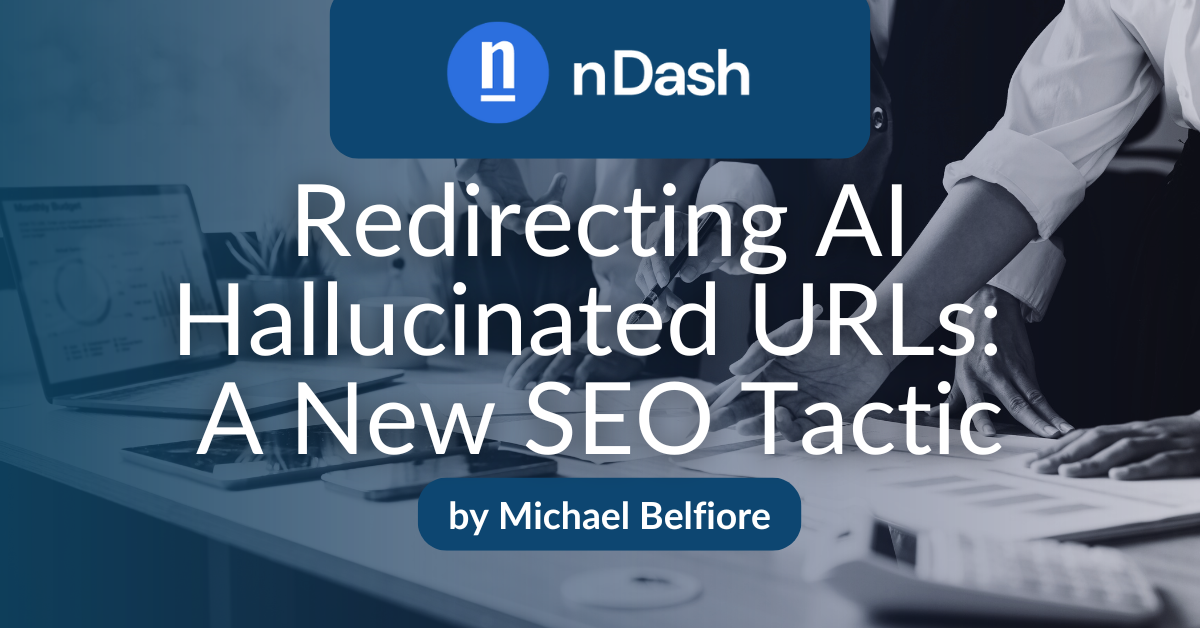Generative AI platforms like ChatGPT have an unfortunate tendency to generate hallucinated URLs. But savvy marketers are turning those errors into SEO wins.
What Are AI Hallucinated URLs?
Hallucinated URLs are fictional links that show up in generative AI outputs. They can mislead users, but they can also create unexpected opportunities for marketers.
Defining Hallucinated URLs
Hallucinated URLs are made-up links in AI responses that may look plausible but point to non-existent pages. Instead of random strings of characters, they’re typically logically structured URLs that represent an AI’s best guess for actual pages based on the patterns in its training data.
Where They Come From
AIs observe patterns in existing URLs and may extrapolate what they “think” should be there. For instance, if your blog regularly publishes SEO guides at /blog/, an AI might confidently reference /blog/internal-links/, even if that specific page doesn’t exist.
Why AI Hallucinated URLs Are a Growing SEO Concern
Marketers need to get on top of hallucinated links because they can negatively impact brand traffic, analytics, and user experience.
One SEO professional, SE Ranking’s Anastasia Kotsiubynska, discovered traffic to some 70 non-existent URLs in three months of 404 (page not found) logs. Some of those URLs received more than 20 hits—enough traffic to prompt her action.
But, as Kotsiubynska learned, hallucinated URLs can represent opportunities to capture more traffic.
Missed Traffic Opportunities
Real or not, hallucinated URLs invite users to click, search, or type them into search bars. Researchers at Ahrefs analyzed 16 million URLs and found that AIs direct visitors to non-existent web pages at nearly three times the rate of regular Google Search. Those bad links add up to hundreds of thousands of lost visitor opportunities.
Damaged UX or Bounce Risk
A 404 response creates friction and kills trust, especially if users believe missing content should exist. When users arrive at your site expecting and not finding information, an AI assistant confidently told them you have, they’re likely to bounce rather than explore further.
How to Monitor for Traffic to AI Hallucinated URLs
The first step in managing hallucinated URL traffic to your site is to identify when and where it occurs. Here’s how.
Analyze 404 Logs
Look for 404 errors in Google Analytics or other traffic analysis tools.
Use Analytics to Spot Strange Entry Points
Filter your analytics to show visits from AI assistants; most analytics tools now allow you to segment traffic by referral source.
Manually Test Prompts
Have your team run prompts in AI tools to see if your brand is being cited with incorrect URLs. This step can reveal patterns in how AI systems hallucinate URLs based on your domain, giving you insights into the content users expect you to have.
What to Do When You Find an AI Hallucinated URL
Here’s how to turn a hallucination into a strategic redirect and capture that lost traffic.
Add Current Features, Stats, and CTAs
A hallucinated URL may represent an opportunity to put your latest product updates, statistics, and offers front and center. It can also be a creative opportunity for a new kind of “404 Oops” page that acknowledges the AI hallucination issue while providing unexpected value.
Create a Redirect to a Relevant Resource
Use a 301 redirect to permanently redirect the hallucinated URL to the most relevant real content, such as your feature page, blog, or resource hub. That way, users who click on hallucinated links won’t hit a dead end but instead land on helpful, relevant content. For example, if an AI hallucinates a URL like /blog/bestproducts/, redirect visitors to an actual product gallery.
Build The Missing Page
If enough traffic is going to a relevant hallucinated URL, consider actually building a page that matches the prompt or search intent.
Kotsiubynska found that about 20% of hallucinated URLs she examined had at least one backlink, suggesting that other sites had referenced these non-existent pages.
If a hallucinated URL represents a genuine content gap and is attracting meaningful traffic, creating that page can capture an opportunity that AI systems have identified for you.
Track the Redirect’s Performance
Use page-level analytics to monitor user interactions after redirection. Are visitors engaging with the content to which they’ve been redirected? For example, are they making purchases or filling out contact forms? This data will help you understand whether your redirect strategy is delivering value for you or if you need to make adjustments.
Technical SEO Best Practices for Redirecting AI Traffic
Here’s how to avoid common pitfalls when managing hallucinated URL redirects.
Use 301s, Not 302s
Permanent redirects, signalled via 301 codes on your site, preserve link equity and tell search engines that a shift is intentional. In contrast, 302 redirects signal that changes are temporary. Since hallucinated URLs represent a permanent gap you’re filling, 301s are the appropriate choice.
Avoid Redirect Loops
Don’t redirect hallucinations to pages that link to more errors; monitor redirect chains regularly. Your users will thank you.
Update Your Sitemap (If Applicable)
If a hallucinated page is now real, make sure it’s appropriately indexed and included in your XML sitemap. That step will help search engines discover and index your new content, maximizing its visibility beyond just the AI-referred traffic.
Turning Hallucinations Into SEO Wins
Reframe the problem as an opportunity: redirecting AI hallucinations is one of the easiest ways to capture “ghost” traffic.
Own the Narrative
If the traffic is high enough, build new content around the themes or phrasing in hallucinated links; clearly, there’s AI interest in those topics. Let hallucinations serve as unintentional keyword research, revealing what users expect to find when they search for your brand.
Capture Mid-Funnel Attention
Visitors coming to your site from hallucinated links are warm; they’re showing up wanting content from you. Use that expectation to your advantage by greeting them with highly relevant content that addresses their specific needs.
Showcase Authority with Custom Landing Pages
If you’re being hallucinated for a specific tool, phrase, or idea, lean in and create a destination that reinforces your expertise. Doing so will help you position your brand as the authoritative source the AI system “believes” you to be, turning a technical glitch into a branding opportunity.
Redirection as a Future-Forward AI SEO Strategy
AI hallucinations may be a glitch, but they’re also a growth lever for forward-thinking marketers.
While AI search tools like ChatGPT, Perplexity, and Claude currently account for a small fraction of total website traffic, the quality of this traffic matters. And it is likely to grow with AI-driven search. That will make hallucinated URL monitoring an increasingly important part of any marketer’s technical audit routine.
For more about upgrading your content marketing practice, download our free resource, An Enterprise Marketer’s Guide to Scaling Content in 2025.
About the Author

Michael Belfiore fell in love with technology and writing at the age of six and hasn’t looked back. He has written about rockets and robots for Wired and National Geographic, books on spaceflight and advanced technology development for HarperCollins, and everything from the future of work to quantum computing for tech brands and news sites. He lives in New York’s Hudson Valley. Check out his nDash profile for more information: Michael Belfiore.
